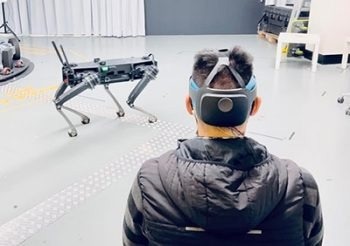This newly developed sensor robot might sound like something from science fiction. By putting on a specialized, electronic headband, you can control a robot using your mind.

A new sensor design integrated into a blue headband was used to wirelessly control a robot using only brain waves. Image Credit: Adapted from ACS Applied Nano Materials, 2023, doi.org/10.1021/acsanm.2c05546.
By designing a unique, 3D-patterned structure that does not depend on sticky conductive gels, a research team has made a so-called “dry” sensor that has the potential to quantify the electrical activity of the brain, even among hair, curves, and bumps of the head.
With the help of electroencephalography (EEG), physicians can track electrical signals from the brain with specialized electrodes either implanted into or positioned on the head’s surface.
EEG assists in diagnosing neurological disorders, but it could also be integrated into “brain-machine interfaces,” which make use of brain waves to regulate an external device, like a robot, prosthetic limb, or even a video game.
The majority of the non-invasive versions include the use of “wet” sensors, which are stuck onto the head with a gloopy gel that could cause irritation to the scalp and, at times, activate allergic reactions.
As a substitute, scientists have been developing “dry” sensors that do not require gels, but so far nothing has worked as well as the gold-standard wet variety.
Even though nanomaterials like graphene could be an ideal option, their flat and normally flaky nature makes them inconsistent with the uneven curves of the human head, especially over prolonged periods.
Hence, Francesca Iacopi and collaborators wished to create a 3D, graphene-based sensor depending on polycrystalline graphene that could precisely track brain activity without any stickiness.
The team created several 3D graphene-coated structures with different shapes and patterns, each around 10 µm thick. Of the shapes tested, a hexagonal pattern worked the best on the curvy, hairy surface of the occipital region—the spot at the base of the head where the brain’s visual cortex is located.
Eight such sensors were incorporated into an elastic headband by the team, which held them against the back of the head. On integration with an augmented reality headset displaying visual cues, the electrodes have the potential to detect which cue was being viewed, and further work with a computer to interpret the signals into commands that regulate the motion of a four-legged robot—entirely hands-free.
Even though the newly developed electrodes failed to work well like the wet sensors, the scientists say that this work constitutes a first step toward developing strong and easily implemented dry sensors to help extend the applications of brain-machine interfaces.
The authors acknowledge financial support from the Defense Innovation Hub of the Australian Government and support from the Australian National Fabrication Facility of the University of Technology Sydney and the Research & Prototype Foundry at the University of Sydney Nano Institute.
Journal Reference
Faisal, S. N., et al. (2023) Noninvasive Sensors for Brain–Machine Interfaces Based on Micropatterned Epitaxial Graphene. ACS Applied Nano Materials. https://doi.org/10.1021/acsanm.2c05546.